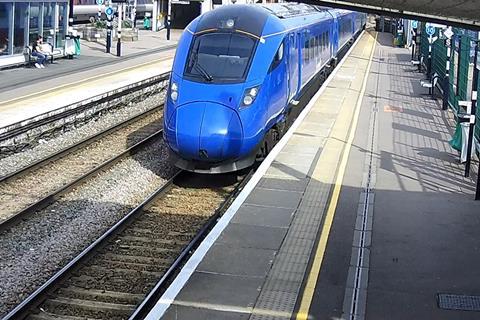
UK: The Rail Accident Investigation Branch makes recommendations covering junction risk management and luggage safety in its report into an incident when a Lumo train passed over points north of Peterborough station at excessive speed. This led to some passengers being thrown from their seats and luggage falling from the overhead storage, causing minor injuries.
On April 17 2022, the 08.20 train from Newcastle to London King’s Cross operated by FirstGroup-owned open access operator Lumo traversed the points at Spital Junction at 122 km/h, well above the maximum permitted 48 km/h.
RAIB found that the driver had controlled the speed appropriately for the through route rather than the slower diverging line. It said the driver’s actions had almost certainly resulted from a strong expectation that the train was being routed straight ahead and so they did not notice, or account for, the junction indicator. It said the driver’s training did not provide them with sufficient understanding of the conditions that could be expected at the signal.
RAIB said the train was close to a speed that would have led to it overturning, and it was likely that some of the wheels lifted off the rails.
On May 1 2023 a Grand Central train was involved in an overspeeding incident at the same location.
RAIB’s first recommendation in its report published on July 10 is for Lumo to review its processes to ensure that it effectively controls the risk of overspeeding at diverging junctions.
The second recommendation asks Network Rail to identify junctions where there is a greater potential for overspeeding.
The third asks Network Rail and operators to consider and implement risk control measures at the junctions identified.
The fourth recommendation is intended to ensure that Lumo minimises the risks from falling luggage; half of the injuries to passengers originated from luggage falling from overhead racks.
Two learning points relate to the need for drivers to maintain alertness when approaching junction signals, and for operator’s emergency plans to specifically include processes to deal with the aftermath of overspeeding incidents.
‘The risk associated with particular junctions and drivers varies with infrastructure configuration and driver expectation’, said Chief Inspector of Rail Accidents Andrew Hall. ‘It is therefore absolutely necessary that Network Rail and train operating companies work together to mutually understand and sufficiently mitigate risks of this type at specific locations, accounting for the rolling stock and operations involved.’
In a statement following the publication of the report, Lumo said it had taken the matter ‘extremely seriously’, and that it had implemented all the recommended actions.
The operator added that the report ’highlights that there were a number of factors that caused the incident, and there are a now a number of important lessons for all rail operators to learn, which we fully support’.



